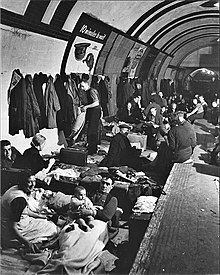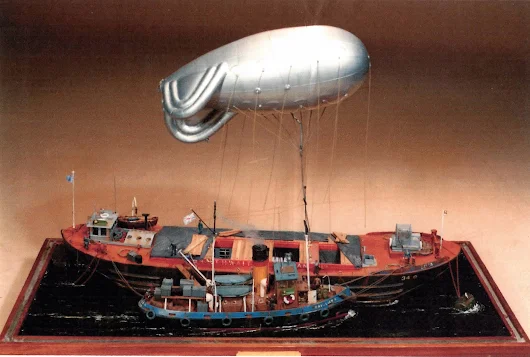received a direct hit on Saturday, 3 May 1941 during a German attack on the north-east coast of England, 107 occupants lost their lives when heavy machinery fell through the ceiling of the
in which they were sheltering.
.......
Many other types of tunnels were adapted for shelters to protect the civil population, and the military and administrative establishment in the UK during the war. Some had been built many years before, some had been part of an ancient defence system, and some had belonged to commercial enterprises, such as coalmining.
The
Victoria tunnels at
Newcastle upon Tyne, for example, completed as long ago as 1842, and used for transporting coal from the collieries to the river Tyne, had been closed in 1860 and remained so until 1939. 12 m deep in places, the tunnels, stretching in parts beneath the city of Newcastle, were converted to air raid shelters with a capacity for 9,000 people. Furthermore, tunnels linked to
landing stages built on the
River Irwell in
Manchester at the end of the 19th century were also used as air-raid shelters.
The large medieval labyrinth of tunnels beneath
Dover Castle had been built originally as part of the defensive system of the approaches to England, extended over the centuries and further excavated and reinforced during World Wars I and II, until it was capable of accommodating large parts of the secret defence systems protecting the British Isles. On 26 May 1940 it became the headquarters under
Vice Admiral Bertram Ramsay of “
Operation Dynamo”, from which the rescue and evacuation of up to 338,000 troops from France was directed.
In
Stockport, six miles south of Manchester, four sets of underground air raid shelter tunnels for civilian use were dug into the red sandstone on which the town centre stands. Preparation started in September 1938 and the first set of shelters was opened on 28 October 1939. (Stockport was not bombed until 11 October 1940.) The smallest of the tunnel shelters could accommodate 2,000 people and the largest 3,850 (subsequently expanded to take up to 6,500 people.) The largest of the
Stockport Air Raid Shelters are open to the public as part of the town's museum service.
In southeast London, residents made use of the
Chislehurst Caves beneath
Chislehurst, a 22-mile-long (35 km) network of caves which have existed since the
Middle Ages for the mining of
chalk and
flint.
.......
Prior to the beginning of the war, shelter policy had been determined by
Sir John Anderson, then Lord Privy Seal and, on the declaration of war, Home Secretary and Minister of Home Security. Anderson announced the policy to Parliament on 20 April 1939, based on a report from a committee chaired by Lord Hailey. This reaffirmed a policy of dispersal and eschewed the use of deep shelters, including the use of tube stations and underground tunnels as public shelters. Reasons given were the spread of disease due to the lack of toilet facilities at many stations, the inherent danger of people falling onto the lines, and that people sheltering in the stations and tunnels might be tempted to stay in them day and night because they would feel safer there than outside the stations.
None of these concerns had been borne out by experience during the bombing raids of the First World War, when eighty specially adapted tube stations had been pressed into use, but in a highly controversial decision in January 1924, Anderson, then chairman of the Air Raid Precautions Committee of Imperial Defence and had ruled out the tube station shelter option in any future conflict.
Following the intensive bombing of London on 7 September 1940 and the overnight raids of 7/8 September, there was considerable pressure to change the policy but, even following a review on 17 September, the Government stood firm. On 19 September, William Mabane, parliamentary secretary to the Ministry of Home Security, urged the public not to leave their
Anderson shelters for public shelters, saying it deprived others of shelter. "We're going to improve the amenities in existing shelters," he promised. "We're setting about providing better lighting and better accommodation for sleeping and better sanitary arrangements." The Ministries of Home Security and Transport jointly issued an "urgent appeal", telling the public "to refrain from using Tube stations as air-raid shelters except in the case of urgent necessity".
However, the Government was then confronted with an episode of mass disobedience. Over the night of 19/20 September, thousands of Londoners were taking matters in their own hands. They had flocked to the Tubes for shelter. At some stations, they began to arrive as early as 4pm, with bedding and bags of food to sustain them for the night. By the time the evening rush hour was in progress, they had already staked their "pitches" on the platforms. Police did not intervene. Some station managers, on their own initiatives, provided additional toilet facilities. Transport Minister John Reith, and the chairman of London Transport, Lord Ashfield, inspected
Holborn tube station to see conditions for themselves.
The Government then realised that they could not contain this popular revolt. On 21 September, it abruptly changed policy, removing its objections to the use of tube stations. In what it called part of its "deep shelter extension policy", it decided to close the short section of
Piccadilly line from Holborn to
Aldwych, and convert different sections for specific wartime use, including a public air raid shelter at Aldwych. Floodgates were installed at various points to protect the network should bombs breach the tunnels under the Thames, or large water mains in the vicinity of stations. Seventy-nine stations were fitted with bunks for 22,000 people, supplied with first aid facilities and equipped with chemical toilets. 124 canteens opened in all parts of the tube system. Shelter marshals were appointed, whose function it was to keep order, give first aid and assist in case of the flooding of the tunnels.
Businesses (for example
Plessey Ltd) were allowed to use the Underground stations and unopened tunnels, government offices were installed in others and the anti-aircraft centre for London used a station as its headquarters.
However, tube stations and tunnels were still vulnerable to a direct hit and several such incidents did occur:
On 14 October 1940, a bomb penetrated the road and tunnel at
Balham tube station, blew up the water mains and sewage pipes, and killed 66 people.
At Bank station a direct hit caused a crater of 120 ft by 100 ft on 11 January 1941, the road above the station collapsed and killed 56 occupants.
However, the highest death toll was caused during an accident at the unfinished
Bethnal Green tube station on 8 March 1943, when 1,500 people entered the station. The crowd suddenly surged forwards on hearing the unfamiliar sound of a new type of anti-aircraft rocket being launched nearby. Someone stumbled on the stairs, and the crowd pushing on, were falling on top of one another, and 173 people were crushed to death in the disaster.
Nevertheless, the London Underground system during the war was considered one of the safest means of protecting relatively many people in a high-density area of the capital. An estimated 170,000 people sheltered in the tunnels and stations during World War II. Although not a great number in comparison to the total number of the inhabitants of the capital, it almost certainly saved many lives of the people who probably would have had to find alternative, less secure means of protection.
Artists and photographers such as
Henry Moore and
Bill Brandt[13] were employed as war artists to document life in London's shelters during the Second World War.
.......
A segment shelter manufactured by the
Stanton Ironworks,
Ilkeston, Derbyshire. The shop producing spun-concrete lighting columns ceased production and turned over to concrete air-raid shelters, of which
100,000 tons were manufactured,
principally for the air ministry.
Reinforced concrete proved an ideal material for air-raid shelters, being strong and resistant to shock with no deterioration with the passing of time. This type of segment shelter was of simple design and of low cost—any length of shelter could be built up from the
pre-cast steel reinforced concrete segments. The segments were
20 inches wide; a pair of them formed an
arch 7 feet high and transverse struts were provided to ensure rigidity. These fitted into longitudinal bearers which were grooved to receive the foot of each segment. Each pair of segments was bolted together at the apex of the arch and each segment was also bolted to its neighbour, the joints being sealed with a bituminous compound. The convenient handling of these segments enabled them to be transported onto sites where close access by motor lorry was not possible.
Partly buried in the ground, with a
suitably screened entrance, this bolted shelter afforded
safe protection against blast and splinters.
https://en.wikipedia.org/wiki/Air_raid_shelter#United_Kingdom




